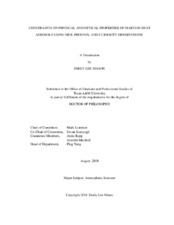| dc.description.abstract | The Martian atmosphere is dominated by the presence of irregularly shaped dust aerosols.
These aerosols affect the vertical temperature profile and initiate dynamical responses on
local, regional, and global scales. In order to quantify the effects of dust in dynamic and
radiative transfer modeling, it is necessary to determine its physical and optical properties.
This dissertation focuses on physical property retrievals of dust pertaining to particle
size and shape distribution. Sky brightness observations taken at the Phoenix landing site
and the Mars Exploration Rovers (MER) Opportunity and Spirit locations can be modeled
using select phase functions within a Discrete Ordinate Radiative Transfer code. Each
phase function is dependent on the physical properties of dust, including effective size and
variance of the distribution and shape.
Retrievals return values near 1.5 µm for particle size for Phoenix data sets using two
different phase function models. This is consistent with previous work. Shape can be constrained
using surveys with large scattering angle range. The particle sizes are consistent
between models. The benefit of using an ellipsoidal shape is that the corresponding phase
function model is physical, self-consistent, and available over a wider range of wavelengths.
Fits to MER data return some variation in particle size, which is more evident
at Opportunity sites than for Spirit sites. The methodology for retrieving particle size is
unique and does not depend on the assumption of particle shape.
In addition to particle size information, we present a quicklook method for retrieving
optical depth from the newest rover, Mars Science Laboratory (MSL) Curiosity, in Gale
crater. This method shows promise in filling in the gaps for past optical depth observation
as well as providing information for operational use. | en |


